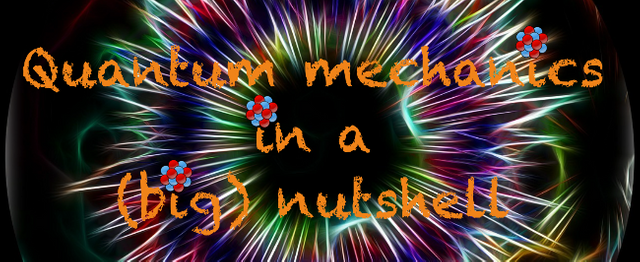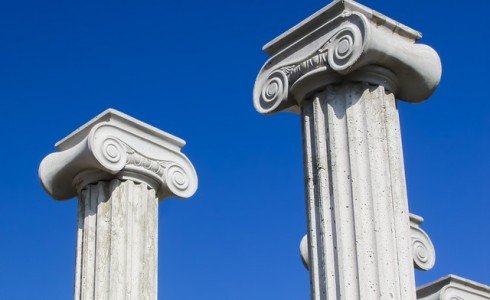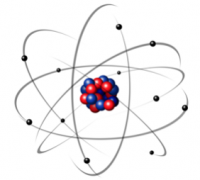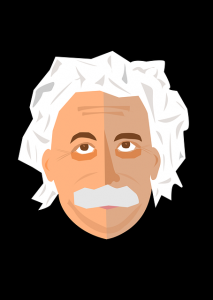
Finally, after a while (really sorry about that), I have managed to write this fourth post of my quantum mechanics lecture notes series shared on Steemit.
I have introduced this topic with my three first posts, detailing the founding principles of quantum mechanics, the elementary particles, interactions and conservation laws as well as the composite systems of particles covered in this notes.
I am now slowly moving towards the main meat of these lessons, and will discuss in details, in this post and the next few ones, the origins of quantum mechanics.

[image credits: pixabay]
THE THREE PILLARS OF CLASSICAL PHYSICS
Quantum mechanics progressively appears between 1900 (the discovery of the Planck constant) and 1927 (the write-up of the postulates of quantum mechanics), and originates from the theoretical and experimental results of the previous century.
At the end of the 19th century, physics was holding on three pillars. These consist of newtonian mechanics (developed by Newton and Lagrange), electromagnetism (developed by Maxwell) and thermodynamics (developed by Carnot). This is what is now today as classical physics.
Newtonian mechanics offer a theoretical framework capable of describing the motion of any physical systems that could be considered at that time.
Maxwell equations allowed to describe radiation in terms of electromagnetic waves, and they have been experimentally confirmed by Hertz at the end of the 19th century.
Finally, classical thermodynamics is born from the study of thermal machines. The first principle of thermodynamics (from Carnot, but also from Mayer, von Helmoltz and Clausius) concerns energy conservation while the second principle introduce a notion, named entropy, that drives the evolution of a physical system.
The second principle, together with the fact that the evolution of a system is irreversible, paves the way to statistical mechanics. This domain has been developed by Maxwell, Boltzmann and Gibbs, and for the first time, a probabilistic description of a physical system is considered. This happened well before quantum mechanics!

[image credits: pixabay]
LIMITATIONS OF CLASSICAL PHYSICS
At the end of the 19th century, a small set of problems have destroyed the hope for classical physics to be the ultimate theory of nature.
Among those issues, one can for instance point out that Maxwell equations are not compatible with newtonian mechanics. Moreover, chemists have demonstrated the existence of atomic radiation spectra that cannot be explained by classical physics, and macroscopic physical systems named black bodies cannot be described by classical physics too. I will come back to all of this into the next few posts.
As a consequence, new theoretical frameworks have been proposed at the beginning of the 20th century, like special and general relativity (which newtonian mechanics is the low velocity limit) and non-relativistic and relativistic quantum mechanics.
In the quantum world, the separate concepts of waves and particles are unified. This is the key concept that will be described all along this series of posts.

[image credit unknown (everywhere on the web)]
TOWARDS TO DISCOVERY OF THE ATOMIC STRUCTURE
In order to understand the origins of quantum mechanics, it is important to first wrap up the status of microscopic physics at the beginning of the 20th century, since it consisted of the seeds for the development of quantum mechanics.
The knowledge of the microscopic world is however rather limited at that time, so that it will be quick. The atomic structure is for instance unknown, and even the idea of the existence of atoms is not unanimously accepted. One of the specific reasons is that the constituents of the atomic nuclei have not all been experimentally discovered.
The beginning of the scientific investigation of atoms and their properties was probably when X-rays have been discovered in 1895 by Röntgen. This opened the path to the study of various forms of radiation and had led one year later to the discovery of radioactivity by Becquerel.
In the same year, Perrin showed that cathodic radiation is made of negatively charged particles. Electrons where born. This was independently confirmed in 1897 by Thomson. Take home message at that time: electrons exist as particles.
The idea of an atomic core, or nucleus, came a bit later and originated from the work of Rutherford on helium. He showed that the mass of a helium atom is concentrated in a tiny region around the atomic center.
Models of planetary atoms were born, where negatively charged electrons are orbiting around a positively charged center. This has in particular inspired Bohr who proposed a model, named the Bohr model, that will play a key role in the development of quantum mechanics. This model is also known as the old quantum theory. I will come back to this in a further post.
A bit further in time, Rutherford introduced the word proton in 1919, when studying the hydrogen atom that is the simplest and most abundant atom in the universe. One had to wait until 1932 for Chadwick to introduce the concept of neutrons. Although the ideas of quantum mechanics exist since 1927, the discovery of the neutron is really the starting point of the quantum analysis of the atomic nuclei.
To finish this list of experimental facts, one must also emphasize that the idea of light being made of elementary particles proposed by Einstein has only been experimentally verified by Compton in 1923. The name photon has further appeared for the first time in 1926 (and has been proposed by Lewis).
THE THEORETICAL SETUP AROUND 1900
On the theory side, the key year is 1905 where four revolutionary articles have been published by Einstein.

[image credits: pixabay]
The first one presents the idea that radiation is quantized, which can explain the photoelectric effect discovered by Hertz in 1887. That is one of the founding articles of quantum mechanics.
Two other articles concern the discovery of special relativity from the pioneering works of Lorentz and Poincaré. Special relativity consists of one the building blocks of modern particle physics (together with field theory and quantum mechanics), and has been generalized in 1917, still by Einstein, to what is called general relativity.
Finally, the last article presents an explanation for the random motion of macroparticles in a fluid, named brownian motion. This is less relevant for the purpose of these lecture notes.
SUMMARY
In this post, I have briefly summarized the status of theoretical and experimental physics at the beginning of the 20th century. I have discussed classical physics, or physics as it was known at that time, and emphasized some of its limitations that have given birth to quantum mechanics.
I have also described historically the different discoveries that have lead to the current description of the atomic structure (which will be the example I will use to introduce the equations behind quantum mechanics in the next articles).
In future posts, I will come back to what I introduced in this article but with many more details. I will hence move on with a detailed description of the failures of classical physics, like the atomic radiation spectra (my next post) and the existing issues from the previous centuries with the modeling of the properties of the black bodies (my next-to-next post).
Nice job @lemouth I look forward to your explanations of atomic radiation spectra. Hopefully you do a better job explaining it then I did :D
Downvoting a post can decrease pending rewards and make it less visible. Common reasons:
Submit
Note that you put the bar quite high :)
Downvoting a post can decrease pending rewards and make it less visible. Common reasons:
Submit
Well I am no physicist, so I expect my bar to be hurtled easily :D
Downvoting a post can decrease pending rewards and make it less visible. Common reasons:
Submit
Wow this is a mega post. You sum up so much and do it in a style that is both readable and interesting. I find the history and context just as interesting as the discoveries themselves. I look forward to the posts where you go into more depth too. I think some of the human stories of discovery can be as gripping as a good thriller!
Downvoting a post can decrease pending rewards and make it less visible. Common reasons:
Submit
Thanks a lot for your comment!
History (and the lessons taken for history) are always useful to understand the next steps. This is what I will try to do with the next few posts of this series: following the pioneering developments of 100 years ago that have led to the establishment of quantum mechanics as a correct way of describing nature.
Please be patient for the next posts... I do my best with the time I have :)
Downvoting a post can decrease pending rewards and make it less visible. Common reasons:
Submit
No problem take your time. I know it will be good.
Downvoting a post can decrease pending rewards and make it less visible. Common reasons:
Submit
Your posts as always are epic. Excellent work as always!
Downvoting a post can decrease pending rewards and make it less visible. Common reasons:
Submit
Thanks a lot for your comment and constant support :)
Downvoting a post can decrease pending rewards and make it less visible. Common reasons:
Submit